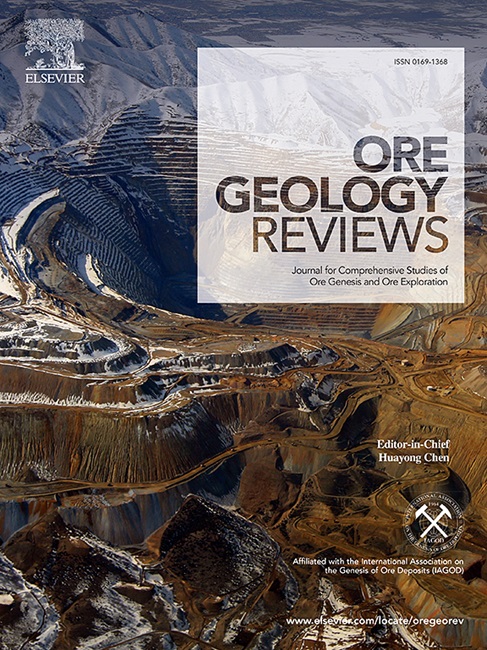Element migration and hydrothermal alteration of the Tuwaishan orogenic gold deposit in West Hainan Island, South China
IF 3.2
2区 地球科学
Q1 GEOLOGY
引用次数: 0
Abstract
The Tuwaishan orogenic gold deposit, located in the western part of Hainan Island, South China, is a structurally controlled gold deposit formed during the Triassic. It is one of several gold deposits hosted within Mesoproterozoic terranes, primarily granitoids with minor contributions from schists and gneisses. The source of ore-forming fluids and materials for these deposits remains a subject of debate. This study investigates the trends and magnitude of element migration in ores and altered wall rocks during gold mineralization and associated hydrothermal alteration, using mass balance calculations based on new geochemical data from ores and altered samples at the Tuwaishan gold deposit. Our results reveal significant enrichment in SiO2, K2O, Au, Ag, As, Bi, Pb, Cd, Cu, W, Sb, Zn, In, Tl, Cs, Rb, V, Zr, Hf, and Eu, alongside notable depletion in TFe2O3, FeO, Na2O, Mo, Sr, Sc, Co, and Ni. In contrast, no measurable mass change was observed for TiO2, Nb, and Ga. Additionally, we document the geochemical separation of Mo from W and Au within the Tuwaishan gold deposit. Our findings indicate that the iron contributing to sulfide mineral precipitation was entirely derived from granitic mylonites during fluid-wall rock interactions, with the alteration of biotite to chlorite representing the dominant alteration process in the deposit. We propose that metamorphism of Ordovician-Silurian sedimentary rocks at depth, triggered by the collision between the South China and Indochina blocks, provided the ore-forming fluids, gold, and associated metals responsible for the formation of the Gezhen shear zone gold deposits. Furthermore, we suggest that phase separation and water–rock interactions were the primary mechanisms controlling gold precipitation at the Tuwaishan deposit. These findings provide new insights into the formation of Phanerozoic orogenic gold deposits hosted in Precambrian terranes.

求助全文
约1分钟内获得全文
求助全文
来源期刊

Ore Geology Reviews
地学-地质学
CiteScore
6.50
自引率
27.30%
发文量
546
审稿时长
22.9 weeks
期刊介绍:
Ore Geology Reviews aims to familiarize all earth scientists with recent advances in a number of interconnected disciplines related to the study of, and search for, ore deposits. The reviews range from brief to longer contributions, but the journal preferentially publishes manuscripts that fill the niche between the commonly shorter journal articles and the comprehensive book coverages, and thus has a special appeal to many authors and readers.
 求助内容:
求助内容: 应助结果提醒方式:
应助结果提醒方式:


